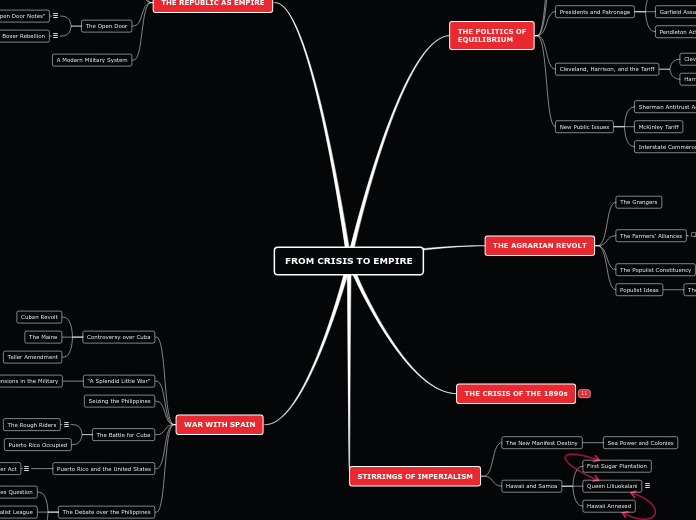FROM CRISIS TO EMPIRE
THE POLITICS OF
EQUILIBRIUM
The Party System
High Voter Turnout
Reasons for Party Loyalties
The National Government
First Pension System
Presidents and Patronage
Stalwarts and Half-Breeds
Garfield Assassinated
Pendleton Act
Cleveland, Harrison, and the Tariff
Cleveland Elected
Harrison Elected
New Public Issues
Sherman Antitrust Act
McKinley Tariff
Interstate Commerce Act
THE AGRARIAN REVOLT
The Grangers
The Farmers’ Alliances
Ocala Demands
People’s Party Established
The Populist Constituency
Populist Ideas
The Populists’ Reform Program
THE CRISIS OF THE 1890s
STIRRINGS OF IMPERIALISM
The New Manifest Destiny
Sea Power and Colonies
Hawaii and Samoa
First Sugar Plantation
Queen Liliuokalani
Hawaii Annexed
THE REPUBLIC AS EMPIRE
Governing the Colonies
Platt Amendment
The Philippine War
Emilio Aguinaldo
Gradual Shift to Self-Rule
The Open Door
Hay’s “Open Door Notes”
Boxer Rebellion
A Modern Military System
WAR WITH SPAIN
Controversy over Cuba
Cuban Revolt
The Maine
Teller Amendment
“A Splendid Little War”
Racial Tensions in the Military
Seizing the Philippines
The Battle for Cuba
The Rough Riders
Puerto Rico Occupied
Puerto Rico and the United States
Foraker Act
The Debate over the Philippines
The Philippines Question
Anti-Imperialist League
Arguments for Annexation
